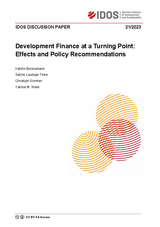Development finance at a turning point: effects and policy recommendations
Berensmann, Kathrin / Sabine Laudage Teles / Christoph Sommer / Yabibal M. WalleDiscussion Paper (21/2023)
Bonn: German Institute of Development and Sustainability (IDOS)
ISBN: 978-3-96021-224-9
DOI: https://doi.org/10.23661/idp21.2023
Preis: 6 €
Development finance is at a turning point, as the macroeconomic environment has changed profoundly and the financing gap for low- and middle-income countries has widened. The events that led to this new situation are the multiple crises that the global economy is facing, such as the climate crisis, the COVID-19 crisis and the war in Ukraine. As a result, interest rates have risen sharply over the past year and are not expected to decline anytime soon. High interest rates further restrict low- and middle-income countries’ access to international financial markets by making borrowing more expensive. At the same time, debt levels in several countries are rising to levels that are almost impossible to repay. Poorer countries find themselves in a trap where financing the Sustainable Development Goals (SDGs) becomes a distant goal for them.
To “get back on track” in financing the 2030 Agenda and the SDGs, a number of reform proposals have been put forward within several processes and initiatives, including the Financing for Development (FfD) process, the Bridgetown Initiative and the Macron-led Paris Summit. Despite being initiated by different actors, these proposals all highlight the importance of reforming the international financial architecture in view of the changed macroeconomic environment. The Hamburg Sustainability Conference in June 2024, the United Nation’s Summit of the Future in 2024 and the next FfD Conference in 2025 should be used to strengthen and accelerate ongoing reform processes and come up with new, innovative and bold proposals to reshape development finance in these challenging times. Against the background of the multiple crises and its effects, our key recommendations for the reform of development finance are as follows.
First, new initiatives and frameworks are needed to provide urgent debt relief and restructuring for highly indebted countries. The international community should promote a reformed G20 Common Framework for debt restructuring and discuss a green Heavily Indebted Poor Countries (HIPC)-like initiative for debt relief for low-income countries as a solution on a case-by-case basis, integrating short-term shock remedies with long-term sustainable development finance. Debt and climate risks should be addressed simultaneously by better incorporating climate risks in debt sustainability analyses conducted by the International Monetary Fund (IMF) and the World Bank, and by considering the volume of investments in climate adaptation because these investments reduce the risks associated with climate change.
Second, tax revenues – the most important source of development finance – need to increase and countries need to expand their fiscal space by reforming their tax administrations and policies. Building fiscal buffers can help countries to become more resilient to future crises. In the short run, eliminating unnecessary tax expenditures such as fossil fuel subsidies is the lowest-hanging fruit to increase tax revenues, while in the long run, more green fiscal reforms (e.g. carbon pricing and environmental taxes) are needed, as well as more effective international tax cooperation. In addition, donor funds should be increased to provide technical assistance and capacity-building to tax and customs administrations.
Third, the Development Assistance Committee member countries should at least halve the gap between their current contributions and the official development assistance (ODA) contribution target of 0.7 per cent of gross national income by 2026, and reach the full attainment of the target by 2030. In particular, donors need to provide ODA in addition to (not as a substitute for) climate finance and channel more ODA to the poorest countries. In this regard, donors should report climate and development finance separately to mitigate the risk of over-reporting.
Fourth, we recall the need to reform multilateral development banks (MDBs). The multiple crises have made the role of MDBs in closing the development financing gap even more important than before. As attracting private capital is becoming more difficult for low- and middle-income countries, MDBs should harness their proven ability to leverage private finance for financing the SDGs. MDBs should substantially increase their lending capacity, for example by lowering their equity to loan thresholds and raising additional capital from shareholders or private investors. MDBs should be reformed to include in their vision the provision of global public goods, such as tackling the climate crisis and preparing for pandemics. Development banks and private creditors should include clauses on natural disasters and pandemics in their financing instruments.





